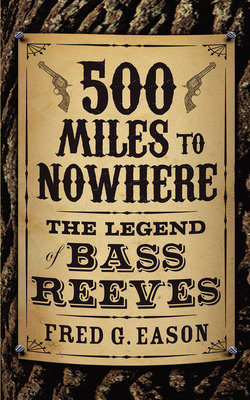Читать книгу 500 Miles to Nowhere - Fred Eason - Страница 3
На сайте Литреса книга снята с продажи.
Foreword
ОглавлениеThis book is based on some true stories about Bass Reeves and some fictional stories about Bass Reeves imagined by the author. By all historical accounts, Bass was an exceptional U.S. Marshal serving under Judge Parker’s Court. According to history, he was selected by Judge Parker because of his previous experience as a bounty hunter out of the prior Van Buren Court. He was also selected because of his ability to speak all of the Indian languages. He learned their languages while he was a runaway slave during and after the Civil War. His race did not seem to be an issue with Judge Parker, although it was obvious that there was a lot of prejudice during that time among white people. The most interesting thing about Bass Reeves, as only one of a handful of black marshals, is that the vast majority of criminals in the Indian Territory were white. One could imagine the potential conflicts involving a black lawman and mostly white criminals.
During his lifetime, Bass became friends with Belle Star, who was friends with Frank James and Bob Dalton and other interesting characters of the time. Many of the events in this book are fictional, even though many of the characters were real. History does not say that Colonel George Reeves was the father of Bass Reeves. The author simply draws that conclusion in the book based upon the relationship between the two men and the fact that both Bass and his mother lived in the Reeves’ home and were treated like family.
The time period covered is the time when Judge Parker’s court was the only law that existed other than the Indian Police, the “Lighthorse.” Criminals were executed by order of Parker, with no appeal to a higher court. That period covers the time from 1875, when Judge Parker began to preside, until the court was ended in 1896. Even though he caused many men to be put to death, history shows that Judge Parker was against capital punishment. The geography of the events in the book are historically correct, occurring in the Indian Territory which is now the State of Oklahoma.
Deputy U.S. Marshals, J.H. Mershon, William P. Pittcock, Bud Kell and Heck Thomas were all living and working for U.S. Marshal Colonel Thomas Boles and Judge Parker at that time.
This book is primarily fiction which is loosely based upon the life of Bass Reeves, and is not intended to be historically correct.
There are a number of very good books which discuss the actual history of Bass Reeves. Perhaps the most historically correct book was Black Gun, Silver Star, written by Art T. Burton. Art T. Burton was a professor of history at South Suburban College in South Holland, Illinois. He also wrote the book Black, Buckskin, and Blue and the book, Black, Red, and Deadly.
Paul L. Brady wrote a book The Black Badge that includes interviews with descendants of Bass Reeves, which would include Paul L. Brady. In 1972, Brady was the first African American to be appointed as a Federal Administrative Law Judge, where he served for 25 years.
There is also a book that was written for children by R. Gregory Christie called Bad News for Outlaws, The Remarkable Life of Bass Reeves, Deputy U.S. Marshal.
The “Bible” for facts regarding Judge Isaac C. Parker’s court, is called Hell on the Border, written in about 1898 by S.W. Harman and C.P. Sterns. Many of the facts in this novel were taken from this great book. Parts of Judge Parker’s famous charge to a Grand Jury has been used from the above source.
Wikipedia also provided some interesting facts about the life of Bass Reeves.
All of the above books can be ordered from Amazon.com.
